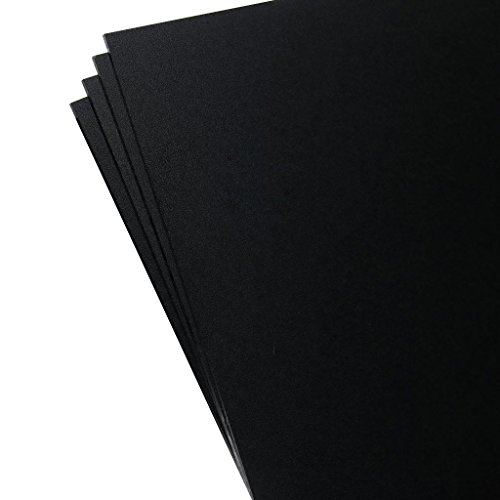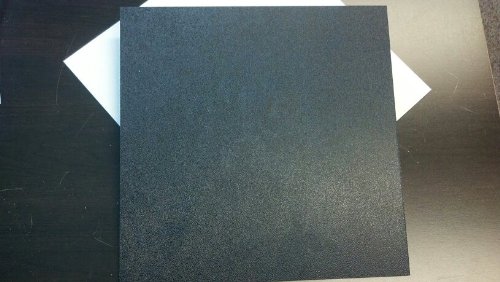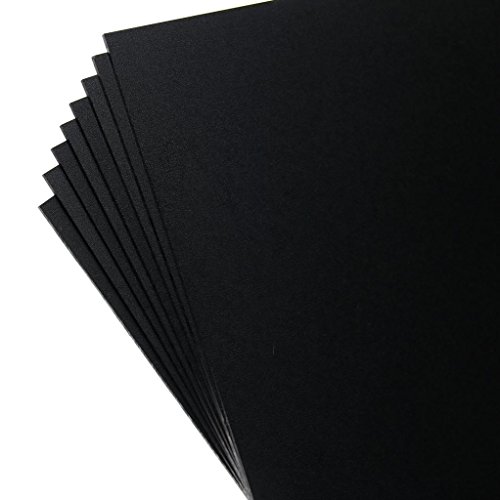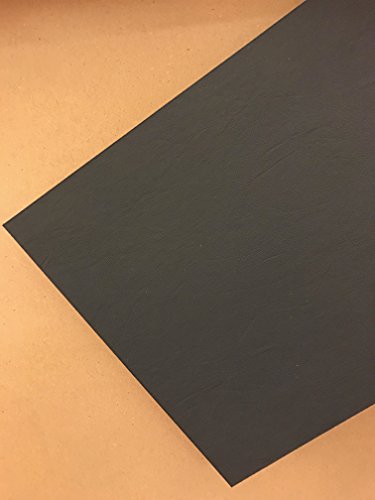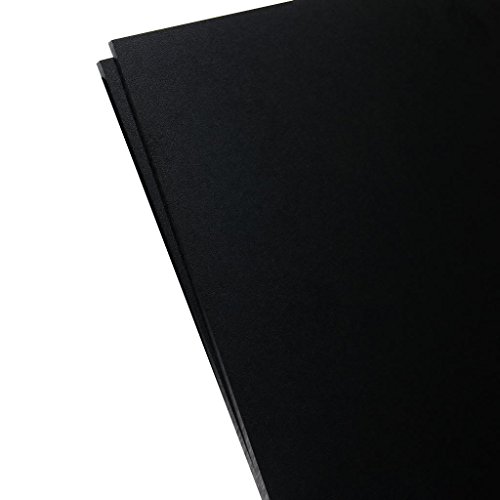If you looking for kydex sheet .125 then you are right place. We are searching for the best kydex sheet .125 on the market and analyze these products to provide you the best choice.
Reviews
1. KYDEX V - Black 12" x 12" x 0.125" PACK of 8 sheets
Description
KYDEX V KYDEX V sheet has excellent forming properties, which results in uniform wall thicknesses and crisp detail. KYDEX V sheet forms to deep draws with low forces when heated to the upper end of the forming temperature range. Unlike many other thermoforming sheets, KYDEX V sheet has unusually high resistance to hot tearing. Forming Guidelines - Oven temperatures should be set differently than the settings used for ABS or FR-ABS. - Typical heater settings (percentage timers) are 30% - 50% top heaters and 50% - 70% bottom heaters. - The most frequent problem is trying to heat the sheet too quickly, particularly on the primary surface. - Cycle times will vary depending on the oven conditions and grade of KYDEX V sheet being formed. - When forming KYDEX V sheet, it is better to rely on the sheet appearance during heating than on fixed cycle times. - Forming temperatures - Guidelines: (Sheet should not exceed 204C (400F). 165 - 177C (330 - 350F) for < 1.50mm (0.060"). 182 - 196C (360 - 385F) for 1.50mm to 3.20mm (0.060" to 0.125"). 196 - 204C (385 - 400F) for > 3.20mm (0.125") - Ideally the core sheet temperature should be within 10F of the surface temperature. Sheet Appearance During Heating As KYDEX V sheet is heated, the inherent stresses in the sheet will relax. Stage I: The heating is marked by wide undulations and softening. Stage II: The material will start to form small ripples (known as oil canning). . Stage III: The material will start to smooth out and sag (KYDEX V sheet will generally sag less than other thermoplastics due to its high melt strength. . Stage IV: The ripples will have smoothed out indicating that most stresses have been removed. 10 to 30 seconds afterwards the sheet is ready to form.2. Plastics 2000 - KYDEX Sheet - 0.080" Thick, Black, 8" x 12", 4 PACK
Feature
Higher breakage resistance than competitive thermoplastics as measured by the Notched Izod testAmong the most rigid of thermoforming materials with a modulus of elasticity of 2,482 MPa (360,000 psi)
Easy to form with excellent part definition and deep-draw characteristics
Great for knife sheaths and gun holsters
Made in USA
Description
KYDEXKYDEX sheet has excellent forming properties, which results in uniform wall thicknesses and crisp detail. KYDEX sheet forms to deep draws with low forces when heated to the upper end of the forming temperature range. Unlike many other thermoforming sheets, KYDEX sheet has unusually high resistance to hot tearing.
Forming Guidelines
- Oven temperatures should be set differently than the settings used for ABS or FR-ABS.
- Typical heater settings (percentage timers) are 30% - 50% top heaters and 50% - 70% bottom heaters.
- The most frequent problem is trying to heat the sheet too quickly, particularly on the primary surface.
- Cycle times will vary depending on the oven conditions and grade of KYDEX sheet being formed.
- When forming KYDEX sheet, it is better to rely on the sheet appearance during heating than on fixed cycle times.
- Forming temperatures - Guidelines: (Sheet should not exceed 204C (400F).
165 - 177C (330 - 350F) for < 1.50mm (0.060").
182 - 196C (360 - 385F) for 1.50mm to 3.20mm (0.060" to 0.125").
196 - 204C (385 - 400F) for > 3.20mm (0.125")
- Ideally the core sheet temperature should be within 10F of the surface temperature.
Sheet Appearance During Heating
As KYDEX sheet is heated, the inherent stresses in the sheet will relax.
Stage I: The heating is marked by wide undulations and softening.
Stage II: The material will start to form small ripples (known as oil canning). .
Stage III: The material will start to smooth out and sag (KYDEX sheet will generally sag less than other thermoplastics due to its high melt strength. .
Stage IV: The ripples will have smoothed out indicating that most stresses have been removed. 10 to 30 seconds afterwards the sheet is ready to form.
3. Kydex T Sheet, P3 Velour Matte, Logo Green, Meets UL 94V0 and 945V Specifications, 1/8" Thickness, 12" Width, 24" Length
Feature
Kydex T is a durable, easy-to-form plastic that is highly resistant to impact and abrasionKydex T has a higher impact strength and is more moisture resistant than fire-retardant ABS/PVC (FR-ABS)
Meets UL 94V0 and 945V specifications for flame retardance
P3 velour matte texture provides mar and abrasion resistance
Logo green color
Description
The Kydex T sheet has a P3 velour matte texture and a logo green color, and meets UL 94V0 and 945V specifications for flame retardance. Kydex T is a tough, durable plastic that is easily formed and extruded. It offers high impact strength and abrasion resistance and is more resistant to impact and moisture than fire-retardant ABS/PVC (FR-ABS). One side has a P3 velour matte texture, and the other side is smooth. The P3 velour matte texture is less rough and less visible than a P1 haircell texture, but still provides mar and abrasion resistance. The textured side cleans with a soft cloth.
Plastic refers to a group of synthetic or semi-synthetic materials that have been engineered to achieve specific properties. The most notable characteristics of plastic are its low weight, machinability, corrosion resistance, and typically good thermal and electrical insulating properties. Depending on their properties, certain plastic grades can be used as alternatives to metal, glass, and ceramic. Some grades also offer optical clarity, a low-friction or self-lubricating surface, or exceptional impact resistance. Unlike metal, plastic may experience creep, which is deformation caused by longtime exposure to a constant load.
Tensile strength, used to indicate the materials overall strength, is the peak stress it can withstand before it breaks. Corrosion resistance describes the material's ability to prevent deterioration caused by atmosphere, moisture, or other medium. Wear resistance indicates the ability to prevent surface damage caused by contact with other surfaces. Toughnessdescribes the material's ability to absorb energy before breaking, while hardness (commonly measured as indentation hardness) describes its resistance to permanent surface deformation. Impact resistance is the measure of a materials ability to absorb a shock of energy before breaking.
Kydex manufactures thermoplastic sheets. The company, headquartered in Bloomsburg, PA, meets International Organization for Standardization (ISO) standards 9001 and 14001.
4. 8"x12"x1/8" BLACK ABS PLASTIC SHEET CUSTOM STEREO TEXTURED FRONT SMOOTH BACK
Description
8" x 12" x 0.125" ABS Plastic Panel AUTOMOTIVE GRADE ONE SIDE IS HAIRCELL TEXTURED AND THE OTHER SIDE SMOOTH COLOR IS BLACK5. KYDEX V - Black 12" x 12" x 0.125" pack of 1 sheet
Description
KYDEX V KYDEX V sheet has excellent forming properties, which results in uniform wall thicknesses and crisp detail. KYDEX V sheet forms to deep draws with low forces when heated to the upper end of the forming temperature range. Unlike many other thermoforming sheets, KYDEX V sheet has unusually high resistance to hot tearing. Forming Guidelines - Oven temperatures should be set differently than the settings used for ABS or FR-ABS. - Typical heater settings (percentage timers) are 30% - 50% top heaters and 50% - 70% bottom heaters. - The most frequent problem is trying to heat the sheet too quickly, particularly on the primary surface. - Cycle times will vary depending on the oven conditions and grade of KYDEX V sheet being formed. - When forming KYDEX V sheet, it is better to rely on the sheet appearance during heating than on fixed cycle times. - Forming temperatures - Guidelines: (Sheet should not exceed 204C (400F). 165 - 177C (330 - 350F) for < 1.50mm (0.060"). 182 - 196C (360 - 385F) for 1.50mm to 3.20mm (0.060" to 0.125"). 196 - 204C (385 - 400F) for > 3.20mm (0.125") - Ideally the core sheet temperature should be within 10F of the surface temperature. Sheet Appearance During Heating As KYDEX V sheet is heated, the inherent stresses in the sheet will relax. Stage I: The heating is marked by wide undulations and softening. Stage II: The material will start to form small ripples (known as oil canning). . Stage III: The material will start to smooth out and sag (KYDEX V sheet will generally sag less than other thermoplastics due to its high melt strength. . Stage IV: The ripples will have smoothed out indicating that most stresses have been removed. 10 to 30 seconds afterwards the sheet is ready to form.6. 4 Kydex Plastic Sheets Black 12" X 12" X .080"
Feature
Kydex is an extremely durable acrylic/PVC alloyDescription
ONE SIDE IS LIGHT HAIRCELL ( P3 FINISH) TEXTURED AND THE OTHER SIDE SMOOTH COLOR IS CALCUTTA BLACK7. 24"x48"x 1/4" (.250") ABS PLASTIC SHEET TEXTURED FRONT SMOOTH BACK VACUUM FORMING THERMOFORMING BLACK
Description
24" x 48" x 0.125" ABS Plastic Panel AUTOMOTIVE GRADE ONE SIDE IS HAIRCELL TEXTURED AND THE OTHER SIDE SMOOTH COLOR IS BLACK All Sizes Are Nominal. Also do Custom Cuts.8. KYDEX V - Black 12" x 24" x 0.125" pack of 1 sheet
Description
KYDEX V KYDEX V sheet has excellent forming properties, which results in uniform wall thicknesses and crisp detail. KYDEX V sheet forms to deep draws with low forces when heated to the upper end of the forming temperature range. Unlike many other thermoforming sheets, KYDEX V sheet has unusually high resistance to hot tearing. Forming Guidelines - Oven temperatures should be set differently than the settings used for ABS or FR-ABS. - Typical heater settings (percentage timers) are 30% - 50% top heaters and 50% - 70% bottom heaters. - The most frequent problem is trying to heat the sheet too quickly, particularly on the primary surface. - Cycle times will vary depending on the oven conditions and grade of KYDEX V sheet being formed. - When forming KYDEX V sheet, it is better to rely on the sheet appearance during heating than on fixed cycle times. - Forming temperatures - Guidelines: (Sheet should not exceed 204C (400F). 165 - 177C (330 - 350F) for < 1.50mm (0.060"). 182 - 196C (360 - 385F) for 1.50mm to 3.20mm (0.060" to 0.125"). 196 - 204C (385 - 400F) for > 3.20mm (0.125") - Ideally the core sheet temperature should be within 10F of the surface temperature. Sheet Appearance During Heating As KYDEX V sheet is heated, the inherent stresses in the sheet will relax. Stage I: The heating is marked by wide undulations and softening. Stage II: The material will start to form small ripples (known as oil canning). . Stage III: The material will start to smooth out and sag (KYDEX V sheet will generally sag less than other thermoplastics due to its high melt strength. . Stage IV: The ripples will have smoothed out indicating that most stresses have been removed. 10 to 30 seconds afterwards the sheet is ready to form.9. KYDEX V Sheet - 0.080" Thick, Black, 12 x 12 Nominal, 8PACK
Feature
Kydex V is a recycled grade of Kydex 100 and Kydex THigher breakage resistance than competitive thermoplastics as measured by the Notched Izod test
Among the most rigid of thermoforming materials with a modulus of elasticity of 2,482 MPa (360,000 psi)
Easy to form with excellent part definition and deep-draw characteristics
Description
KYDEX VKYDEX V sheet has excellent forming properties, which results in uniform wall thicknesses and crisp detail. KYDEX V sheet forms to deep draws with low forces when heated to the upper end of the forming temperature range. Unlike many other thermoforming sheets, KYDEX V sheet has unusually high resistance to hot tearing.
Forming Guidelines
- Oven temperatures should be set differently than the settings used for ABS or FR-ABS.
- Typical heater settings (percentage timers) are 30% - 50% top heaters and 50% - 70% bottom heaters.
- The most frequent problem is trying to heat the sheet too quickly, particularly on the primary surface.
- Cycle times will vary depending on the oven conditions and grade of KYDEX V sheet being formed.
- When forming KYDEX V sheet, it is better to rely on the sheet appearance during heating than on fixed cycle times.
- Forming temperatures - Guidelines: (Sheet should not exceed 204C (400F).
165 - 177C (330 - 350F) for < 1.50mm (0.060").
182 - 196C (360 - 385F) for 1.50mm to 3.20mm (0.060" to 0.125").
196 - 204C (385 - 400F) for > 3.20mm (0.125")
- Ideally the core sheet temperature should be within 10F of the surface temperature.
Sheet Appearance During Heating
As KYDEX V sheet is heated, the inherent stresses in the sheet will relax.
Stage I: The heating is marked by wide undulations and softening.
Stage II: The material will start to form small ripples (known as oil canning). .
Stage III: The material will start to smooth out and sag (KYDEX V sheet will generally sag less than other thermoplastics due to its high melt strength. .
Stage IV: The ripples will have smoothed out indicating that most stresses have been removed. 10 to 30 seconds afterwards the sheet is ready to form.
10. 2 PACK- SIBE AUTOMATION KYDEX V (P1) PLASTIC SHEETS BLACK 8" X 12" X .125" THICK
Feature
Kydex V is an extremely durable acrylic/PVC alloyDescription
ONE SIDE IS LIGHT HAIRCELL ( P1 FINISH) TEXTURED AND THE OTHER SIDE SMOOTH COLOR IS CALCUTTA BLACK SIBE AUTOMATION HAS ALWAYS A GOOD STOCK OF KYDEX, AS WELL AS OTHER PLASTIC MATERIALS11. Plastics 2000 - KYDEX Sheet - 0.118" Thick, Black, 12" x 12", 2 PACK
Feature
Higher breakage resistance than competitive thermoplastics as measured by the Notched Izod testAmong the most rigid of thermoforming materials with a modulus of elasticity of 2,482 MPa (360,000 psi)
Easy to form with excellent part definition and deep-draw characteristics
Great for knife sheaths and gun holsters
Made in USA
Description
KYDEXKYDEX sheet has excellent forming properties, which results in uniform wall thicknesses and crisp detail. KYDEX sheet forms to deep draws with low forces when heated to the upper end of the forming temperature range. Unlike many other thermoforming sheets, KYDEX sheet has unusually high resistance to hot tearing.
Forming Guidelines
- Oven temperatures should be set differently than the settings used for ABS or FR-ABS.
- Typical heater settings (percentage timers) are 30% - 50% top heaters and 50% - 70% bottom heaters.
- The most frequent problem is trying to heat the sheet too quickly, particularly on the primary surface.
- Cycle times will vary depending on the oven conditions and grade of KYDEX sheet being formed.
- When forming KYDEX sheet, it is better to rely on the sheet appearance during heating than on fixed cycle times.
- Forming temperatures - Guidelines: (Sheet should not exceed 204C (400F).
165 - 177C (330 - 350F) for < 1.50mm (0.060").
182 - 196C (360 - 385F) for 1.50mm to 3.20mm (0.060" to 0.125").
196 - 204C (385 - 400F) for > 3.20mm (0.125")
- Ideally the core sheet temperature should be within 10F of the surface temperature.
Sheet Appearance During Heating
As KYDEX sheet is heated, the inherent stresses in the sheet will relax.
Stage I: The heating is marked by wide undulations and softening.
Stage II: The material will start to form small ripples (known as oil canning). .
Stage III: The material will start to smooth out and sag (KYDEX sheet will generally sag less than other thermoplastics due to its high melt strength. .
Stage IV: The ripples will have smoothed out indicating that most stresses have been removed. 10 to 30 seconds afterwards the sheet is ready to form.
12. SIBE AUTOMATION KYDEX V (P1) PLASTIC SHEETS BLACK 24" X 48" X .125" THICK
Feature
Kydex V is an extremely durable acrylic/PVC alloyDescription
ONE SIDE IS LIGHT HAIRCELL ( P1 FINISH) TEXTURED AND THE OTHER SIDE SMOOTH COLOR IS CALCUTTA BLACK SIBE AUTOMATION HAS ALWAYS A GOOD STOCK OF KYDEX, AS WELL AS OTHER PLASTIC MATERIALS13. 4 ABS Textured Plastic Sheet 1/8" Thick X 12" X 12"

